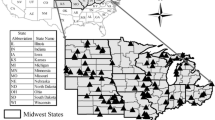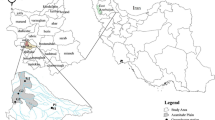Abstract
This paper investigates monthly, seasonal, and annual trends in rainfall, streamflow, temperature, and humidity amounts at Urmia lake (UL) basin and analyzes the interaction between these variables and UL’s water level fluctuation during the 1971–2013 period. Two new methods including nonparametric hybrid wavelet Mann–Kendall test and Şen’s methodology have been used to determine potential trends in the variables and their dominant periods. The results showed significant decreasing trends in the water level and streamflow series, moderate decreasing trend in the rainfall and relative humidity series, and increasing trends in the observed temperature data. The 8- , 12-month, and 2-year periods were detected as the dominant periods of the variables in monthly, seasonal, and annual timescales, respectively. The results from the interaction analysis revealed that the main factor influencing the water level at UL is decreasing trend in the streamflow series. Both the monthly series of UL’s water level and the streamflow series of the stations indicated two start points of significant decreasing trend in 1973 and 1998. Furthermore, a comparative analysis among the applied methods indicated a good agreement between the results of hybrid wavelet Mann–Kendall test and Şen’s trend analyzing method.












Similar content being viewed by others
References
Adamowski K, Prokoph A, Adamowski J (2009) Development of a new method of wavelet aided trend detection and estimation. Hydrol Process 23(18):2686–2696
Alipour S (2006) Hydrogeochemistry of seasonal variation of Urmia Salt Lake, Iran. Saline Syst. https://doi.org/10.1186/17461448-2-9
Amirataee B, Zeinalzadeh K (2016) Trends analysis of quantitative and qualitative changes in groundwater with considering the autocorrelation coefficients in west of Lake Urmia, Iran. Environ Earth Sci 75(5):1–10. https://doi.org/10.1007/s12665-015-4917-2
Chatterjee S, Khan A, Akbari H, Wang Y (2016) Monotonic trends in spatio-temporal distribution and concentration of monsoon precipitation (1901–2002), West Bengal, India. Atmos Res 182:54–75
Chen Y, Guan Y, Shao G, Zhang D (2016) Investigating trends in streamflow and precipitation in Huangfuchuan Basin with wavelet analysis and the Mann–Kendall test. Water 8:77
Danandeh Mehr A, Kahya E (2017) A Pareto-optimal moving average multigene genetic programming model for daily streamflow prediction. J Hydro 549:603–615
Danandeh Mehr A, Kahya E, Olyaie E (2013) Streamflow prediction using linear genetic programming in comparison with a neuro-wavelet technique. J Hydrol 505:240–249
Danandeh Mehr A, Kahya E, Bagheri F, Deliktas E (2014) Successive-station monthly streamflow prediction using neuro-wavelet technique. Earth Sci Inf 7:217–229
Douglas EM, Vogel RM, Kroll CN (2000) Trends in flood and low flows in the United States: impact correlation. J Hydrol 240(1–2):90–105
Drago AF, Boxall SR (2002) Use of the wavelet transform on hydro-meteorological data. Phys Chem Earth 27(32–34):1387–1399
Eimanifar A, Mohebbi F (2007) Urmia lake (northwest Iran): a brief review. Saline Syst 3(5):1–8
Fathian F, Morid S, Kahya E (2015) Identification of trends in hydrological and climatic variables in Urmia lake basin, Iran. Theor Appl Climatol 119:443–464
Fathian F, Modarres R, Dehghan Z (2016) Urmia lake water-level change detection and modeling. Model Earth Syst Environ 2(4):203
Golabian H (2010) Urumia lake: hydro-ecological stabilization and permanence. In: Badescu V, Cathcart R (eds) Macro-engineering seawater in unique environments. Environmental Science and Engineering (Environmental Engineering). Springer, Berlin, Heidelberg, pp 365–397
Hassanzadeh E, Zarghami M, Hassanzadeh Y (2012) Determining the main factors in declining the Urmia lake level by using system dynamics modeling. Water Resour Manag 26:129–145
Jain SK, Kumar V, Saharia M (2013) Analysis of rainfall and temperature trends in northeast India. Int J Climatol 33(4):968–978
Joseph JF, Sharif HO (2016) A methodology for assessing extreme precipitation trends applied to three South Texas Basins, 1898–2011. Arab J Sci Eng 41(12):4945–4951
Kahya E, Kalayci S (2004) Trend analysis of stream flow in Turkey. J Hydrol 289:128–144
Karpouzos DK, Kavalieratou S, Babajimopoulos C (2010) Trend analysis of precipitation data in Pieria Region (Greece). Eur Water 30:31–40
Kendall MG (1975) Rank correlation measures. Charles Griffin, London
Kumar S, Merwade V, Kam J, Thurner K (2009) Streamflow trends in Indiana: effect of long term persistence, precipitation and subsurface drains. J Hydrol 374:171–183
Loo YY, Billa L, Singh A (2015) Effect of climate change on seasonal monsoon in Asia and its impact on the variability of monsoon rainfall in Southeast Asia. Geosci Front 6(6):817–823
Mallat SG (1998) A wavelet tour of signal processing, 2nd edn. Academic Press, San Diego
Mann HB (1945) Nonparametric tests against trend. Econometrica 13:245–259
Mohsin T, Gough WA (2009) Trend analysis of long-term temperature time series in the Greater Toronto area (GTA). Theor Appl Climatol 98:3–4
Nalley D, Adamowski J, Khalil B (2012) Using discrete wavelet transforms to analyze trends in streamflow and precipitation in Quebec and Ontario (1954–2008). J Hydrol 475:204–228
Nourani V, Hosseeini Baghanam A, Adamowski J, Kisi O (2014) Applications of hybrid wavelet–artificial intelligence models in hydrology: a review. J Hydrol 514:358–377
Nourani V, Nezamdoost N, Samadi M, Daneshvar Vousoughi F (2015) Wavelet-based trend analysis of hydrological processes at different timescales. J Water Clim Change 6(3):414–435
Partal T, Kahya E (2006) Trend analysis in Turkish precipitation data. Hydrol Process 20:2011–2026
Partal T, Kücük M (2006) Long-term trend analysis using discrete wavelet components of annual precipitations measurements in Marmara region (Turkey). Phys Chem Earth 31:1189–1200
Rehman S (2013) Long-term wind speed analysis and detection of its trends using Mann–Kendall test and linear regression method. Arab J Sci Eng 38(2):421–437
Roshan G, Samakosh JM, Orosa JA (2016) The impacts of drying of Lake Urmia on changes of degree day index of the surrounding cities by meteorological modelling. Environ Earth Sci 75(20):1387
Şen Z (2012) Innovative trend analysis methodology. J Hydrol Eng 17:1042–1046
Şen Z (2014) Trend identification simulation and application. J Hydrol Eng 19(3):635–642
Sneyers R (1990) On statistical analysis of series of observations. World Meteorological Organization, Geneva
Vaheddoost B, Aksoy H (2017) Structural characteristics of annual precipitation in Lake Urmia basin. Theor Appl Climatol 128:919–932
Wang W, Ding S (2003) Wavelet network model and its application to the predication of hydrology. Nat Sci 1:67–71
Wang W, Hu S, Li Y (2011) Wavelet transform method for synthetic generation of daily streamflow. Water Resour Manag 25(1):41–57
Yan T, Bai ZS (2017) Spatial and temporal changes in temperature, precipitation, and streamflow in the Miyun Reservoir Basin of China. Water 9(2):78
Zarghami M (2011) Effective watershed management; case study of Urmia lake, Iran. Lake Reserv Manag 27(1):87–94
Zhang X, Harvey KD, Hogg WD, Yuzyk TR (2001) Trends in Canada stream flow. Water Resour Res 37:987–998
Zume J, Tarhule A (2006) Precipitation and streamflow variability in Northwestern Oklahoma, 1894–2003. Phys Geogr 27(3):189–205
Acknowledgements
The authors are grateful to three anonymous reviewers for their instructive comments on this paper.
Author information
Authors and Affiliations
Corresponding author
Rights and permissions
About this article
Cite this article
Nourani, V., Danandeh Mehr, A. & Azad, N. Trend analysis of hydroclimatological variables in Urmia lake basin using hybrid wavelet Mann–Kendall and Şen tests. Environ Earth Sci 77, 207 (2018). https://doi.org/10.1007/s12665-018-7390-x
Received:
Accepted:
Published:
DOI: https://doi.org/10.1007/s12665-018-7390-x




